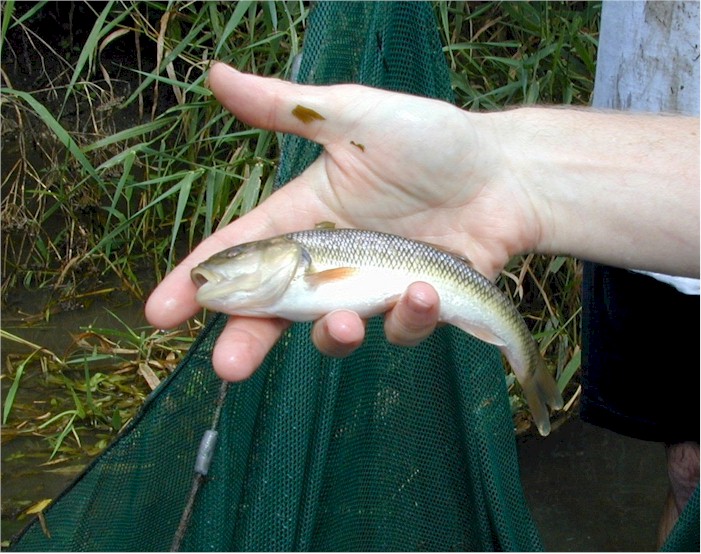On a Father's Day weekend fishing trip, Saturday, June 18, 2011, Nick Anderson of Greenville, NC reeled in a 143 pound blue catfish. The fish was caught in John Kerr Reservoir, more commonly known as Buggs Island Lake, on the Virginia-North Carolina border. According to a local paper, his is still being certified by the Virginia State Record Fish Committee and International Game Fish Association but if the certification is approved, the catfish will not only be a Virginia state record but the new world record for a blue catfish.
On July 20, 2010, a yet to be certified new world record blue catfish was caught by Greg Bernal of Florissant, Mo. on the Missouri River. Greg's girlfriend, Janet Momphard, a nurse from St. Charles, Mo. helped land the world-record fish. The record catfish weighed in at 130 lbs. It was 57 inches long and 45 inches in girth. The previous angling world record was 124 pounds, and was caught by Tim Pruitt on May 22, 2005, in the Mississippi River. This record broke the previous blue catfish record of 121.5 Lbs caught from Lake Texoma, Texas.
Blue catfish are opportunistic predators and will eat any species of fish they can catch, along with crayfish, freshwater mussels, frogs, and other readily available aquatic food sources; some blue catfish have reportedly attacked scuba divers. Catching their prey becomes all the more easy if it is already wounded or dead, and blue cats are noted for feeding beneath marauding schools of striped bass in open water in reservoirs or feeding on wounded baitfish that have been washed through dam spillways or power generation turbines.
Due to their opportunistic nature, blue catfish will usually take advantage of readily accessible food in a variety of situations, which from the angler's perspective makes cut up or dead baits, and even stink baits an excellent choice to target these fish. Blue cats will also respond well to live baits, with live river herring and shad usually a top choice, followed by large shiner minnows, sunfish, suckers, and carp. All of the above baits can be used as fresh cut baits with good success and freshwater drum also work well in this capacity. Generally a fairly large piece of cut bait (4-12 inches long) on a fairly large hook (3/0 to 9/0) is a good choice in rivers or reservoirs where large blue cats (50 pounds and up) are a possibility. Depending on current conditions, sinkers ranging from 1/2 to 8 oz. may be required, with 1-2 oz. a good choice for many situations. To catch large blue catfish in rivers, the more current the better usually, although fishing along current edges and breaks is often a good option. Blue catfish tend to favor deeper water in larger rivers and reservoirs, but will make feeding and spawning forays into relatively shallow water. Blue catfish can be frequently caught in warmer climates in water as shallow as twelve inches. For the largest of specimens, fishing for them requires incredibly powerful tackle, often fishermen targeting these brutes will choose saltwater tackle such as a large heavy action pole with 100lbs line, and 10/0 circle hooks, with a 2 lbs. chunk of cut skipjack herring. Blue catfish are incredible fighters, and are often considered game fish due to their reputation for attacking anything from panfish baits to artificial bass lures.
The blue catfish is the largest species of catfish in the United States, and is surrounded by mystery, legend, and myth. It is often told that these fish can reach astonishing sizes of over 8 ft. in length (96 inches, or about 2.4 meters) but these observations are often overestimates by divers who probably only saw 5 ft. and 130 lbs. specimens, though there are unconfirmed reports of 200 lbs. specimens. This is unlikely since this would mean the catfish would have to gain 5 lbs. annually for their entire life as well as avoid capture for 40 years. Early in the United States these sizes may have been possible, but are probably rare at best in modern times. The best places to find these giants are below large dams, or waterfalls, dams such as the Chickamauga Dam and many others along the Tennessee River are often noted for their large catfish.
Because of their increasing rarity, it is often requested that any fish over 20 lbs. (10 kilograms) be released unharmed to help to retain the population of large specimens, and any fish under 5lbs should also be released unharmed to grow to maturity. The normal eating size for these fish is between 5 and 20lbs, and anything within this range can make an outstanding meal, which is often why fishermen specifically target this species.
On July 20, 2010, a yet to be certified new world record blue catfish was caught by Greg Bernal of Florissant, Mo. on the Missouri River. Greg's girlfriend, Janet Momphard, a nurse from St. Charles, Mo. helped land the world-record fish. The record catfish weighed in at 130 lbs. It was 57 inches long and 45 inches in girth. The previous angling world record was 124 pounds, and was caught by Tim Pruitt on May 22, 2005, in the Mississippi River. This record broke the previous blue catfish record of 121.5 Lbs caught from Lake Texoma, Texas.
Blue catfish are opportunistic predators and will eat any species of fish they can catch, along with crayfish, freshwater mussels, frogs, and other readily available aquatic food sources; some blue catfish have reportedly attacked scuba divers. Catching their prey becomes all the more easy if it is already wounded or dead, and blue cats are noted for feeding beneath marauding schools of striped bass in open water in reservoirs or feeding on wounded baitfish that have been washed through dam spillways or power generation turbines.
 If chicken livers are the best |  Bait Soap and Soap Bait FAQ |  Blue Catfish Best Catfish Bait |  best catfish bait for Blue |  Cedar Creek Lake Blue Catfish |
Texas Catfish Fishing – Top |  The Best Catfish Bait for |  Catfish Bait - Fishing For |  You may catch Catfish year |  What is the Best Bait For Blue |
Because of their increasing rarity, it is often requested that any fish over 20 lbs. (10 kilograms) be released unharmed to help to retain the population of large specimens, and any fish under 5lbs should also be released unharmed to grow to maturity. The normal eating size for these fish is between 5 and 20lbs, and anything within this range can make an outstanding meal, which is often why fishermen specifically target this species.
 Catfish Bait - What Do Channel |  best blue catfish bait. | Catfish Baits - Best baits |  best bait for catfish shad and |  Catfish Catfish Bait |
 Shad is the Best Catfish Bait |  SONNY\x26#39;S CATFISH BAIT |  Baits for Catfish |  flathead catfish catfish best oct it Best+catfish+bait |  Best Catfish Bait Recipes |







































